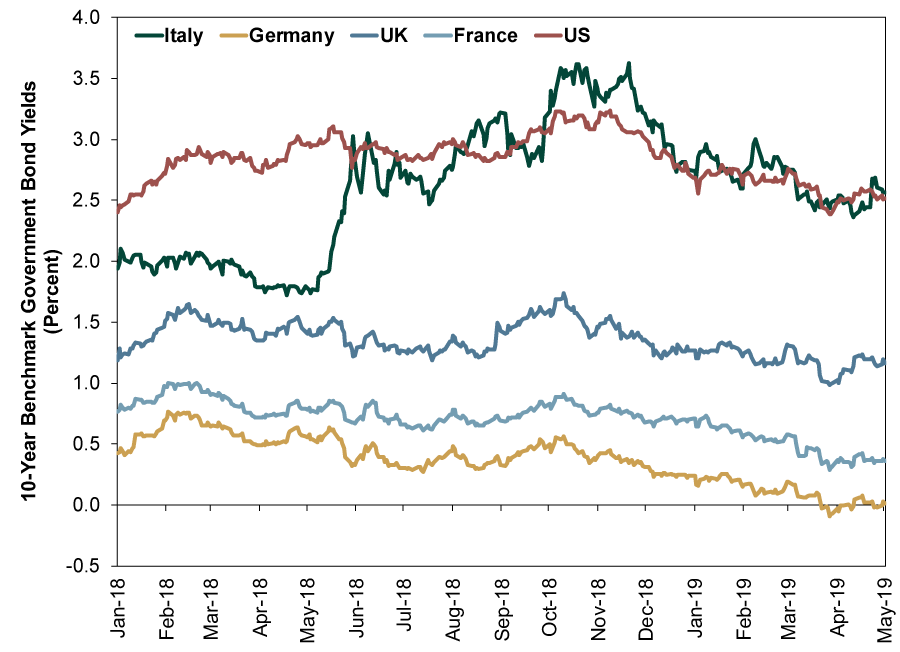Personal Wealth Management / Economics
One Year Later, Italy Is Fine
Bond yields are down, GDP is growing, and the populist government hasn’t done nearly as much as feared.
One year ago today, Italian politics were a mess. Nearly two months after a general election, political leaders still hadn’t formed a government, but the potential for a populist coalition between the anti-establishment Five Star Movement and far-right The League loomed large. Many feared the eurozone’s third-largest economy spiraling into political chaos, recession and—if a populist government implemented all of its parties’ campaign pledges—default. Italian interest rates would soon soar as the very populist government many dreaded indeed took power at May’s close, and as economic data softened, many suspected the worst fears were coming true. Yet now, a year later, a check reveals the government hasn’t done much, interest rates are down, and GDP is growing again. For investors, we think this highlights a timeless lesson: Big fears frequently fizzle, leaving a benign reality in their wake.
In Italy’s case, the big thing everyone feared actually happened. A populist government took power, shaking up the status quo. They pledged bold things, said incendiary things and vowed to take the eurozone by storm. No more deficit limits and edicts from Brussels bureaucrats! There was a new sheriff in town! This would be an age of greater social welfare, flat taxes and a 21st century populist Italian renaissance! Their bluster freaked out the old establishment and, for a while, markets. Italian 10-year yields jumped from below 2% on the early-March election day to more than 3.6% in October, as Rome battled Brussels over its budget and default fears hit fever pitch. Meanwhile, Italian GDP fell two straight quarters in Q3 and Q4 2018, meeting one popular definition of recession.
Yet these days, things are looking up. That budget battle blew over, and Italian 10-year yields are down to 2.56%, effectively even with 10-year US Treasury yields. Tuesday brought the news that Italian GDP rose 0.2% q/q in Q1, perhaps signaling an economic recovery.[i] Even the GDP contraction doesn’t look as bad as first thought, with government spending and a drop in private inventories being the sole negative contributors in Q4 2018. Pure private sector components (household spending and fixed investment) were positive. Not by much, but growth is growth, and unseen private sector growth is a sign Italy was never as bad off as feared. Now that GDP overall has resumed growing, that factoid is simply more apparent.
Another lesson: Beware reading too much into any single country’s interest rate wiggles. For all the chatter over jumpy Italian yields, they were merely part of a global move in 2018’s second half. As Exhibit 1 shows, other major developed markets’ yields also rose last summer and autumn before reversing course in late November. Italian yields were more volatile than the others for a spell, but directionally, they more or less matched, showing that one major developed nation’s yields generally won’t deviate from the rest of the pack for long.
Exhibit 1: 10-Year Government Bond Yields
Source: FactSet, as of 5/1/2019. 10-year benchmark government bond yields for Italy, Germany, the UK, France and the US, 1/1/2018 – 5/1/2019. US yield is the constant-maturity 10-year US Treasury yield.
Politics have also settled. Despite some continued grandstanding, the new government hasn’t done all that much. Instead, reality has set in. A hodgepodge of leftists, so-called techno-libertarians, anti-establishment types without strong ideological leanings and hard-right types was never going to agree on much. The overlap in this ideological Venn diagram is so tiny we doubt we could even concoct a childish hand-drawn chart showing it. Instead of starting the revolution, this government ran headlong into gridlock. Reforms passed by the prior centrist administrations have largely gone untouched. It is a shining example of what Fisher Investments’ founder and Executive Chairman, Ken Fisher, likes to call the “pancaking” of western developed nations’ politics. Political bell curves, once stacked toward the center, have flattened out as formerly fringe parties have eroded centrists’ support. That brings more coalitions like Italy’s, cobbled out of parties that agree on little to nothing. For stocks, this is a-ok—it keeps legislative risk low, easing the fears that accompanied this coalition’s loud entrance. Actually, we suspect this gridlock is one reason Italian stocks are beating global markets year to date. Through Wednesday’s close, the MSCI Italy was up 17.3%, beating the MSCI World Index’s 16.0%.[ii]
The next time big scary stories swirl, remember Italy. Remember how even when the thing everyone feared actually happened, it didn’t bring disaster, and stocks started recovering long before anyone suspected they would.[i] Source: FactSet, as of 5/1/2019. Real GDP growth, seasonally adjusted, Q1 2019.
If you would like to contact the editors responsible for this article, please message MarketMinder directly.
*The content contained in this article represents only the opinions and viewpoints of the Fisher Investments editorial staff.
Get a weekly roundup of our market insights
Sign up for our weekly e-mail newsletter.

See Our Investment Guides
The world of investing can seem like a giant maze. Fisher Investments has developed several informational and educational guides tackling a variety of investing topics.





